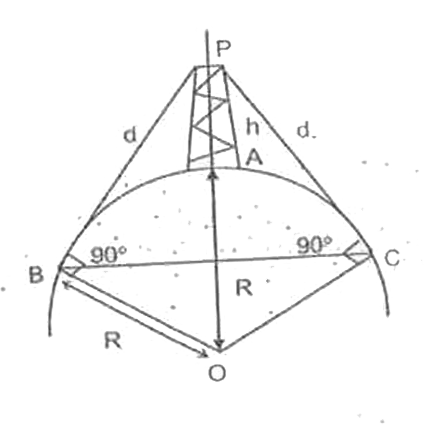(A) : Television signals are propagated through space waves.
(R) : Television signals have frequency in the 100-200 MHz range.
Both 'A' and 'R' are true and 'R' is the correct explanation of 'A'.
Both 'A' and 'R' are true and 'R' is not the correct explanation of 'A'.
A' is true abd 'R' false
A' is false and 'R' is false
The correct Answer is:A
Topper's Solved these Questions
- COMMUNICATION SYSTEMS BOOK - AAKASH SERIESCHAPTER - COMMUNICATION SYSTEMS EXERCISE - Exercise - II (Antenna)
7 Videos
- COMMUNICATION SYSTEMS BOOK - AAKASH SERIESCHAPTER - COMMUNICATION SYSTEMS EXERCISE - Exercise - II (Modulation & Power)
11 Videos
- COMMUNICATION SYSTEMS BOOK - AAKASH SERIESCHAPTER - COMMUNICATION SYSTEMS EXERCISE - Exercise - IA (Line Communication)
10 Videos
- COMMUNICATION SYSTEM BOOK - AAKASH SERIESCHAPTER - COMMUNICATION SYSTEM EXERCISE - LECTURE SHEET (LEVEL - I) (MAIN) (EXERCISE - IV) (Straight Objective & More than one Correct Answer Type Questions)
20 Videos
- CURRENT ELECTRICITYBOOK - AAKASH SERIESCHAPTER - CURRENT ELECTRICITYEXERCISE - PROBLEMS (LEVEL-II)
26 Videos
Similar Questions
Assertion: The television signals are propagated through sky waves. ltbr> Reason: Television signals have freqeuncy in the range of 1000MHz to 2000MHz range.
View SolutionPropagation of radio waves The behaviour of electromagnetic waves of wavelength10−3 m and higher (called radio waves) in their propagation through atmosphere is an important consideration in all modern forms of communication, radio, television, microwaves, etc. At low frequencies, radio waves radiated by an antenna near the earth travel directly following the surface of the earth. This is called wave-along-ground propagation.
Radio waves of frequencies 2 MHz-20 MHz are reflected off the ionosphere. So, radio waves in this frequency range radiated from a certain point can be received at another point on the surface after being reflected by the ionosphere. This is known as skywave propagation.
Television signals have frequencies in the 100-200 MHz range and penetrate ionosphere (no reflection), therefore, their propagation is not possible through sky waves. The reception of such waves is possible only if the receiver antenna directly intercepts the signals. Thus, television broadcasts are made from tall antenna to get larger coverage. This is known as space wave propagation. Answer the following questions.
What is the frequency range of television signals?
View Solution
Knowledge Check
Statement-1: Television signals are propagated through sky waves.
Statement-2 : Television signals have frequency in the 100-200 MHz range.AStatement-1 is true: Statement-2 is true, and Statement-2 is correct explanation of Statement-1.BStatement-1 is true, Statement-2 is true, but Statement-2 is not a correct explanation of Statement-1.CStatement-1 is true, but Statement-2 is false.DStatement-1 is false, but Statement-2 is true.Assertion: The television signals are propagated through sky waves. Reason: Television signals have freqeuncy in the range of 1000MHz to 2000MHz range.
Aa) A and R both are true and R is correct explaination of ABb) A is true but R is falseCc) A is false but R is trueDd) Both are falseAudio in television signals are
Afrequency modulatedBamplitude modulatedCboth frequency and amplitude modulatedDphase modulated
Propagation of radio waves The behaviour of electromagnetic waves of wavelength10−3 m and higher (called radio waves) in their propagation through atmosphere is an important consideration in all modern forms of communication, radio, television, microwaves, etc. At low frequencies, radio waves radiated by an antenna near the earth travel directly following the surface of the earth. This is called wave-along-ground propagation.
Radio waves of frequencies 2 MHz-20 MHz are reflected off the ionosphere. So, radio waves in this frequency range radiated from a certain point can be received at another point on the surface after being reflected by the ionosphere. This is known as skywave propagation.
Television signals have frequencies in the 100-200 MHz range and penetrate ionosphere (no reflection), therefore, their propagation is not possible through sky waves. The reception of such waves is possible only if the receiver antenna directly intercepts the signals. Thus, television broadcasts are made from tall antenna to get larger coverage. This is known as space wave propagation. Answer the following questions.
Television signals travel through ___________ propagation.
View SolutionPropagation of radio waves The behaviour of electromagnetic waves of wavelength10−3 m and higher (called radio waves) in their propagation through atmosphere is an important consideration in all modern forms of communication, radio, television, microwaves, etc. At low frequencies, radio waves radiated by an antenna near the earth travel directly following the surface of the earth. This is called wave-along-ground propagation.
Radio waves of frequencies 2 MHz-20 MHz are reflected off the ionosphere. So, radio waves in this frequency range radiated from a certain point can be received at another point on the surface after being reflected by the ionosphere. This is known as skywave propagation.
Television signals have frequencies in the 100-200 MHz range and penetrate ionosphere (no reflection), therefore, their propagation is not possible through sky waves. The reception of such waves is possible only if the receiver antenna directly intercepts the signals. Thus, television broadcasts are made from tall antenna to get larger coverage. This is known as space wave propagation. Answer the following questions.
What is wave-alongs-ground propagation?
View SolutionHow the television signals are propagated, derive the formula for the area that a T.V. signal will cover

View SolutionHow the television signals are propagated, derive the formula for the area that a T.V. signal will cover

View SolutionAssertion: Television signals are recieved throgh sky-wave propagation.
Reason: The ionosphere reflects em wave of frequencies greater than a critical frequency.
View Solution

